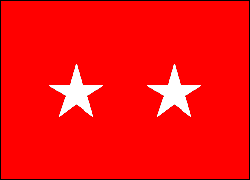
History
The rank of major general was abolished in the U.S. Army by the Act of March 16, 1802 and restored by the Act of January 11, 1812, as preparations were being made for the War of 1812. Major general has been a rank in the U.S. Army ever since.
Until the American Civil War, major general was the highest rank that could be attained by an officer in the U.S. Army, though Winfield Scott had been given the brevet rank of lieutenant general in 1855. This was a consequence of the fact that at his death George Washington was officially listed as holding the rank of lieutenant general, rather than full general, and it was regarded as improper for an officer to hold a rank equal to or superior to Washington’s. To address this anomaly, Washington was posthumously promoted by Congress to the rank of General of the Armies of the United States in 1976.
The position of “Major General Commanding the Army” was entitled to wear three stars according to General Order No. 6 of March 13, 1861.[14] When Ulysses S. Grant was appointed lieutenant general on March 9, 1864[15], and took command of the Union forces, he used the three-star insignia formerly assigned to that position.
The Confederate States Army maintained a similar rank of major general, usually associated with the command of a division, while lieutenant generals often commanded corps and full generals led armies as a general convention.
Today, major generals command divisions (large formations of 10,000 or more Soldiers), Army bases, major commands, or are otherwise invested with significant responsibility and authority.
The following University of Oklahoma Army ROTC alumni have achieved the rank of Major General:
Charles Brown
Edwin Burba
John Doesburg
Geoffrey Lambert
Shelton Lollis
John Long
Ernest Massad
Hal Muldrow
Joe Owens
Clyde Watts
Frank White
